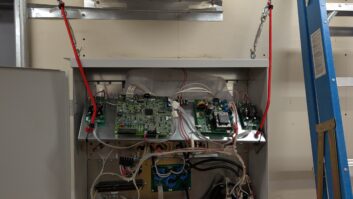Dr. Tine Hicks and his brother Leigh, owners of WBTE Radio in Windsor, N.C., share this interesting variable coil used for HF (3 to 30 MHz) applications.
This was manufactured long ago by Barker & Williamson of Upper Darby, Pa. In the first photo, note the capacitor plates below the coil assembly.

The second image shows how the movable arm can couple more or less of the RF signal.

Do you have an interesting piece of radio or electronics history at hand? Send us a photo and tell us about it. Email [email protected].
I can and you can too
Scott Todd, who describes himself as a classic radio gear nut, loved the article on the refurbished Gates Biamote that we published in September.
If you are into restoring old gear, Scott points you to Hayseed Hamfest LLC. The company can build pretty much any type of can capacitor for you.
Scott notes, however, that defective caps can also be opened and re-stuffed. There are videos on YouTube if you are interested.
Kinky college story
Walt Konetsco is a former Foreign Service officer and field engineer for Voice of America. The photo of crushed coax that Larry Wilkins shared last month brought a smile to Walt’s face, along with memories of a situation he’d experienced years ago.
Walt had his own consulting business and had contracted with a station to install a satellite receiving system. He dutifully installed and sighted the dish, but the station general manager felt he could save money by having a college student on staff run the coax cable from the dish to the interior of the building.
When Walt came back to complete the installation, the coax had indeed been run and buried as he had instructed. But Walt installed the connectors on each end and fired it up. Nothing!
He checked the receiver at the antenna and got an operational signal, leaving the coax as the likely source of the problem. Well, the college student came back and dug up the coax. It had multiple kinks, just like Larry’s photograph and with additional crimps and multiple damaged locations along the line.
When Walt told the GM that he would have to buy a new expensive run of cable to replace the damaged one, he suddenly realized it would have been far less expensive had he simply paid Walt’s hourly rate.
Surge solution
Years ago, Kenneth Lundgren was designing a remote-control console for a CCTV system that used a twisted pair cable to transmit a digital control signal up to a mile away.
The signal went to an IC that would be susceptible to transients on that long twisted pair. Kenneth and his team had an internal standard to test for this. It consisted of charging a 4.7 uF capacitor to 600 volts and then discharging that capacitor into the input terminals. That’s almost 1 joule of energy.
This isn’t huge but enough to zap any semiconductor and to fry a 1/4-watt resistor or a Zener diode. Kenneth’s team needed a protection circuit that could dissipate the 1 joule and at the same time limit the transient voltage to 5 volts.
They developed a two-stage circuit to separately absorb most of the energy and then limit the voltage. One can use a spark gap, but they are expensive. Their solution was to use a good old NE-2 neon bulb, which works just fine.
The NE-2 would absorb the 1 joule but allows about a 70-volt transient to pass. The NE-2 was placed from each input terminal to chassis ground. That was followed by a series 150-ohm resistor and then a 5-volt Zener diode connected to the printed circuit board (PCB) ground. You don’t want the NE-2 ground to go to the PCB ground.
It worked every time, Kenneth reports. If you repeat the test too often, the NE-2s will fail eventually; but for infrequent transients, the circuit does the job.
Wisdom from the bird lady
That photo we published in July of what appears to be nest material in a transmitter room continues to cause chirping and clucking.
Bill Ruck, projects and contract engineer in San Francisco, shared the photo with his wife Sjoban. She reminded him that a nearby abandoned AT&T Trans-Pacific receive building in Point Reyes, Calif., has a continuing problem with broken windows and birds getting in. The staff at Point Reyes National Seashore eventually fix the windows, although they have been known to screw 1/8-inch acrylic across other broken windows to keep birds out.
Birds in a building leave guano everywhere; and when we zoom in on our original photo we can see bird excrement all over the floor, so despite speculation to the contrary, this does appear to be an avian intrusion. But of what kind?
Bill points out that while osprey nest on towers all the time, they’re not cavity nesters and presumably wouldn’t go through an opening like the coax cable ports we discussed.
The mystery continues.
Workbench submissions aren’t for the birds! In fact they’re encouraged and qualify for SBE recertification credit. Email [email protected].






